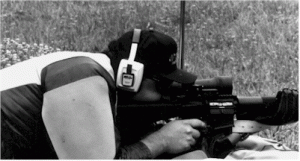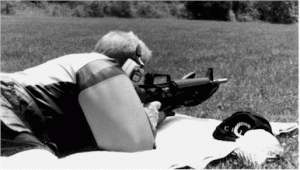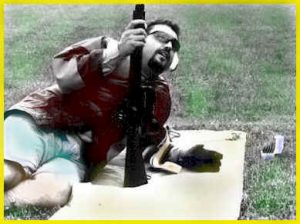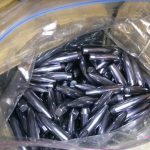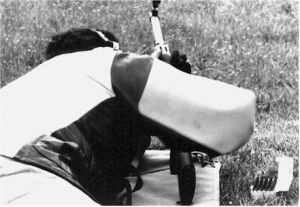 I think I should explain what a “match rifle” is compared to a “service rifle”. I started out the year (1999) under the mistaken impression that Highpower Rifle Competition was all about the “Service Rifle”. This is evidenced by the “DCM AR-15” article found elsewhere in EGPWorld. There may be some people that are under the mistaken impression that the “service rifle” is the only way to shoot Highpower. I hope a lot of people aren’t being turned off by this, because that would be a shame.
I think I should explain what a “match rifle” is compared to a “service rifle”. I started out the year (1999) under the mistaken impression that Highpower Rifle Competition was all about the “Service Rifle”. This is evidenced by the “DCM AR-15” article found elsewhere in EGPWorld. There may be some people that are under the mistaken impression that the “service rifle” is the only way to shoot Highpower. I hope a lot of people aren’t being turned off by this, because that would be a shame.
The great thing about the AR-15 is that it really doesn’t matter all that much either way!
In a nutshell, “service rifle” Highpower competition manifests itself in the form of a “leg match”. A “leg match” is, typically, a 500 point NRA Highpower match that is shot across the course and no sighter shots are allowed. This “no sighters” rule makes it double tough. One had better know their equipment and wind calls, especially in the rapids.
Note: I was at the Nationals at Camp Perry in 1999 during the big “leg match”. I was there just as an observer. Suffice to say, it was very educational. The military teams dominate, without question. Their scores were a minimum of 98% across the board for the Marines and the AMSU. It appeared that half of the military shooters were women, and they appear to be in the pace group. The AR-15 totally rules the event. Wood stocks were few and far between. These people have their poop collated. Do not be the enemy downrange of one these shooters! Be afraid, be very afraid…
The other big distinction of the service rifle class is the rules. A lot of these rules center around the rifle. Basically, the idea originally came from the assumption that the “service rifle” used for “service rifle competition” would be a GI issue rifle or a GI issue rifle of years past. So, in order of issue, this would include the 1903, M1 Garand, M14, and the M16. Over the years, certain “modifications” have been allowed. This started out as ordinance modifications like glass bedding, NM (National Match) gauged parts, and the addition of GI approved target upgrades (the introduction of NM sights). This was Okey Dokey with the Army because they ran the whole deal. This propagated through to later years when Service Rifle became increasingly popular with the public. Once civilian gunsmiths started getting involved the rule became increasingly more “function” or “external appearance”. Modifications could be extensive, as long as the appearance of a NM grade GI rifle remained. This is a little confusing since stainless barrels, non GI wood (laminates) and wood finishes (urethane), and extensive glass bedding (which is all visible externally) are all approved modifications.
There are a few other rules that are Service Rifle specific:
1. Caliber changes are acceptable as long as it is 30-06, .308 or .223.
2. Only GI sized magazines.
3. Only GI sling equipment, including no sling hooks.
4. No use of the shooting coat sling keeper.
5. GI appearance rifles only.
Suffice to say, if you are into AR15’s the Service Rifle is limited to a 20” barrel, DCM style float tube (floats inside, stock handguard outside), carry handle upper (non removable -not approved yet) with “match” A2 sights/standard “match” post front and a 4.5 lbs. trigger. This is really a pretty straightforward setup. What really sucks is what some of this stuff costs!
Once the M16/AR15 came into the fold, there was quite an uproar from the wood gun crowd about how the AR15 would require “non-military” modifications to be competitive. In fact, they said, they have to “single feed” long bullets (80 gr. Sierras) to be competitive at 600 yards.
Well, it is the opinion of the management, that this is a load of poop.
Service Rifle modifications to the AR15 are the easiest (by far) of the lot. I can take a stock rifle and turn it into a standard “DCM” type rifle in about 5-6 hours of assembly and fitting (the trigger will probably take 1-2 hours of the 5-6 hours).
M1 Garand/M14 NM mods take weeks!
I hate to break it to the wood gun guys, but if Lake City Ordinance ever makes a magazine length .223 GI Match ammo, the days of bitching are over. Take a 77 Sierra or the 75 Hornady with 24.5 grs of R15 or 23.5 grs of Varget and it is all over. I guarantee the AR15 will still rule over the wood guns across the course even with these loads fed from the magazine.
There are soooooooooo many other factors involved in the success of the AR15 that have nothing to do with Ballistic Coefficient.
One of the biggies is how much fun it is to shoot these rifles.
Shooting one of these things is a pleasure, because of the reduction in recoil. This reduction in recoil allows the shooter to hug the rear sight, this allows a whole list of advantages. Besides women like ‘em.
I digress….. this is Match Rifle article….
The AR15 Match rifle is really a much more straightforward solution.
Highpower “Match Rifle” is actually a different class from “Service Rifle”. Match rifle has much fewer rules than Service Rifle and almost no limitations on rifle type, caliber, or accessories. Except for a few minor (some stupid) rules, the NRA Match Rifle shooter can do whatever the hell he wants to be competitive. The Match Rifle course is typically 800 points across the course, with 10 more shots than a leg match at 200 yard Offhand, 200 yard sitting rapid, and 300 yard Prone rapid.
The few exceptions (that I know of) are as follows:
1. Rifle must hold a minimum of (5) rounds. (5 and 5 are fired in the rapids instead of the 2 and 8 in Service Rifle).
2. Removable palmrests are not allowed.
3. Detachable magazines must not protrude below the magazine-well for offhand. This is considered a palmrest. This makes the magazine size thing an issue.
4. Sights are “iron sights” except in “any sights” matches. Iron sights have virtually no restrictions.
5. Muzzle breaks are not allowed.
6. Arm pit buttstock hooks are not allowed.
Everything else is pretty much subject to your every whim!
Here is a list of advantages of the match rifle class:
The rifle can have everything just as you want it. A Match Rifle can be virtually hand-fitted to your body, and fully adjustable for every position. Also, the shooter could choose to have a very simple rifle and still be competitive.
Match slings are much easier to use, remove, and install.
The sights can be tailored to your eyes and your individual preference for sight picture (this is biggie folks-especially if your vision is not perfect).
Sling handstops are the norm. This removes the need to cover your whole body in glue (yuck) to get a firm position.
Wildcat calibers are constantly popping up, originating from those handloaders who feel they will find the next standard in accuracy.
How does all of this apply to the AR15 you ask?
The first advantage listed is the most important for the average guy who wants to get into Highpower shooting at his local club. I feel that Highpower rifle is hard enough without adding the extra challenges that are present in the Service Rifle category. There are a lot of AR15’s out there, especially these days, that would be extremely competitive with little or no modification. Large majorities of the new AR15’s that I am seeing at the local gunshows are very well suited to long range, across-the-course shooting right out of the box! I think there is a whole world of shooters out there who do not realize there is a Highpower x-ring machine right in their gunsafe.

![AR-15 Match Rifle vs. Service Rifle (1999) I think I should explain what a “match rifle” is compared to a “service rifle”. I started out the year (1999) under the mistaken impression that Highpower Rifle Competition was […]](https://theurbanrifleman.com/wp-content/uploads/2013/04/5-459x300.gif)
